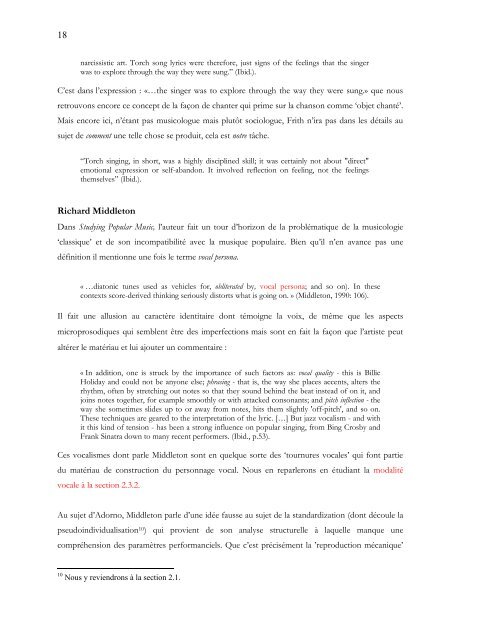You also want an ePaper? Increase the reach of your titles
YUMPU automatically turns print PDFs into web optimized ePapers that Google loves.
18<br />
narcissistic art. Torch song lyrics were therefore, just signs of the feelings that the singer<br />
was to explore through the way they were sung.” (Ibid.).<br />
C’est dans l’expression : «…the singer was to explore through the way they were sung.» que nous<br />
retrouvons encore ce concept de la façon de chanter qui prime sur la chanson comme ‘objet chanté’.<br />
Mais encore ici, n’étant pas musicologue mais plutôt sociologue, Frith n’ira pas dans les détails au<br />
sujet de comment une telle chose se produit, cela est notre tâche.<br />
“Torch singing, in short, was a highly disciplined skill; it was certainly not about "direct"<br />
emotional expression or self-abandon. It involved reflection on feeling, not the feelings<br />
themselves” (Ibid.).<br />
Richard Middleton<br />
Dans Studying Popular Music, l’auteur fait un tour d’horizon de la problématique de la musicologie<br />
‘classique’ et de son incompatibilité avec la musique populaire. Bien qu’il n’en avance pas une<br />
définition il mentionne une fois le terme <strong>vocal</strong> persona.<br />
« …diatonic tunes used as vehicles for, obliterated by, <strong>vocal</strong> persona; and so on). In these<br />
contexts score-derived thinking seriously distorts what is going on. » (Middleton, 1990: 106).<br />
Il fait une allusion au caractère identitaire dont témoigne la voix, de même que les aspects<br />
microprosodiques qui semblent être des imperfections mais sont en fait la façon que l’artiste peut<br />
altérer le matériau et lui ajouter un commentaire :<br />
« In addition, one is struck by the importance of such factors as: <strong>vocal</strong> quality - this is Billie<br />
Holiday and could not be anyone else; phrasing - that is, the way she places accents, alters the<br />
rhythm, often by stretching out notes so that they sound behind the beat instead of on it, and<br />
joins notes together, for example smoothly or with attacked consonants; and pitch inflection - the<br />
way she sometimes slides up to or away from notes, hits them slightly 'off-pitch', and so on.<br />
These techniques are geared to the interpretation of the lyric. […] But jazz <strong>vocal</strong>ism - and with<br />
it this kind of tension - has been a strong influence on popular singing, from Bing Crosby and<br />
Frank Sinatra down to many recent performers. (Ibid., p.53).<br />
Ces <strong>vocal</strong>ismes dont parle Middleton sont en quelque sorte des ‘tournures <strong>vocal</strong>es’ qui font partie<br />
du matériau de construction du <strong>personnage</strong> <strong>vocal</strong>. Nous en reparlerons en étudiant la modalité<br />
<strong>vocal</strong>e à la section 2.3.2.<br />
Au sujet d’Adorno, Middleton parle d’une idée fausse au sujet de la standardization (dont découle la<br />
pseudoindividualisation 10) qui provient de son analyse structurelle à laquelle manque une<br />
compréhension des paramètres performanciels. Que c’est précisément la ’reproduction mécanique’<br />
10 Nous y reviendrons à la section 2.1.














